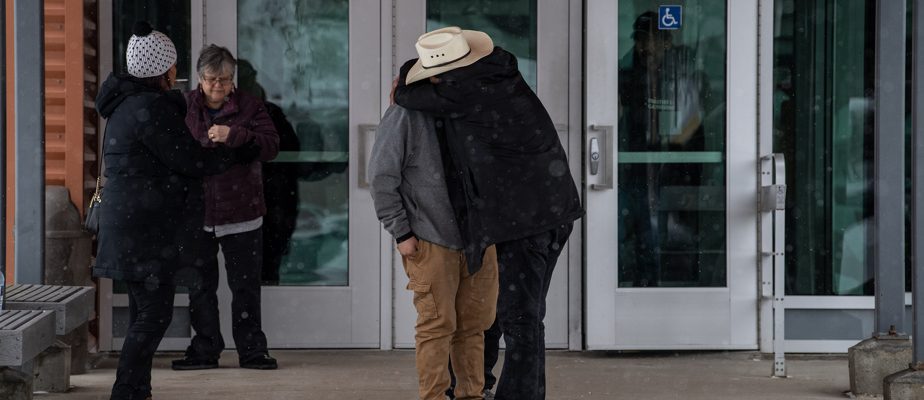(Melfort) Family members hugged and cried at the coroner’s inquest after learning how a mass killer went from house to house, breaking down doors and stabbing members of a Saskatchewan First Nation.
The first 911 calls, released Tuesday during the inquest, show the growing fear of community members as Myles Sanderson, armed with a knife, terrorized the people of the James Smith Cree Nation on September 4, 2022.
” Please hurry up. I’m bleeding,” said Brandon Genereaux, in a call to a 911 operator after being attacked.
Mr. Genereaux survived the violent rampage, but his father, Robert Sanderson, was among 11 people killed on the First Nation and in the neighboring village of Weldon.
There were 92 calls to 911.
Myles Sanderson, 32, died in custody days later.
Staff Sergeant Robin Zentner of the Royal Canadian Mounted Police (RCMP) major crimes unit continued his testimony Tuesday, explaining to jurors how the attacks took place.
Mr. Zentner testified Monday that Myles Sanderson and his brother, Damien Sanderson, had wreaked havoc on the First Nation in the days and hours leading up to the attacks.
The investigation also saw text messages sent by Damien Sanderson to his wife saying he was ready to die.
Damien Sanderson was the first to be killed by his brother. Mr. Zentner said police believed he was killed after Myles Sanderson stabbed his first victim.
Damien Sanderson intervened in that stabbing, Mr. Zentner said, and Myles Sanderson then attacked his brother in a vehicle. Damien Sanderson ran out of the vehicle, leaving a bloody shirt in the road, the inquest heard.
Some family members began crying when the inquest showed images of Damien Sanderson’s shirtless body, where he was later found in long grass on the side of a road.
The investigation, which is taking place in Melfort, northeast of Saskatoon, aims to establish the events that led to the murders, determine who died, as well as when and where each person was killed.
A second inquest into the death of Myles Sanderson is planned for February.
Mr. Zentner was asked if the RCMP had investigated the reason for the killings. He said police discovered text messages exchanged between the brothers and some victims days before the attacks. It was about drug sales and debts, or money owed in prison.
According to Mr. Zentner, RCMP interviews with the family also revealed that Myles Sanderson preyed on anyone associated with the Terror Squad, a gang with a strong presence in Saskatchewan.
However, Mr. Zentner said, there was no indication that the killings were gang-related and some were clearly random.
RCMP have said that because the killer is dead, people may never get all the answers about what happened.
Questions about the police intervention
“There is no way around it, this is an incredibly difficult day of evidence,” said Keith Brown, the lawyer representing the First Nation.
Mr. Brown argued that Mr. Zentner’s testimony was a “thousand-foot view of what was happening from the perspective of a criminal investigator” but that it provided important context.
Mr. Brown asked Mr. Zentner why Aboriginal people do not contact or trust the police. The officer said there could be many reasons, including a historical distrust of the RCMP among Indigenous communities.
Some representatives of family members also asked the police officer questions. Family members of Bonnie and Gregory Burns, a mother and son who were killed, questioned why responding officers stopped at the Melfort detachment before heading into the community.
Mr. Zentner said the questions should be asked of the police officers, who are scheduled to testify on Wednesday.
The inquest heard that a few days before the murders, Myles Sanderson had traveled to the First Nation to sell drugs. He argued with the mother of his children and Damien Sanderson tried to calm him down.
The investigation revealed that the brothers were driving around the community, getting into fights and selling drugs.
As the brothers spent more time together, Damien Sanderson’s text messages to his wife became more fatalistic. Mr. Zentner said Monday that no one had provided a full explanation for the tone of Damien Sanderson’s text messages.
Mr. Zentner’s timeline of attacks includes photos of shoe prints on door frames, blood spilled in homes and videos from responding officers’ vehicles.
He provided insight into how the killer moved through the community, stealing vehicles and injuring residents.
Myles Sanderson’s 13-year-old son was in the basement of the home where Earl Burns Sr., Myles Sanderson’s former stepfather, was attacked. Mr. Burns later died on a school bus he was driving to chase Myles Sanderson.
The boy told police he heard his father tell Mr Burns: “I’m going to kill you and my son,” the inquest heard.
Myles Sanderson bragged about the killings while visiting other First Nation homes.
“You want to know how many bodies I had tonight? ” Mr. Sanderson told a survivor.
Darryl Burns, whose sister Gloria Burns was killed trying to help others, said it was difficult to hear testimony about how drugs might be involved.
“Cocaine is the problem in our community. »
